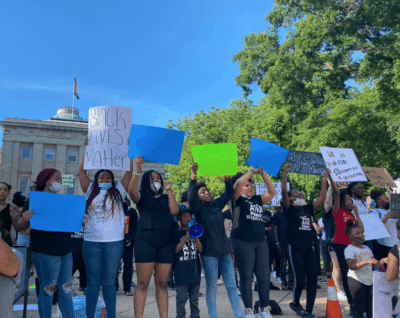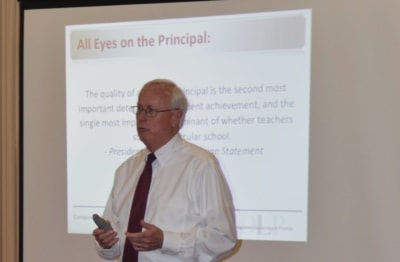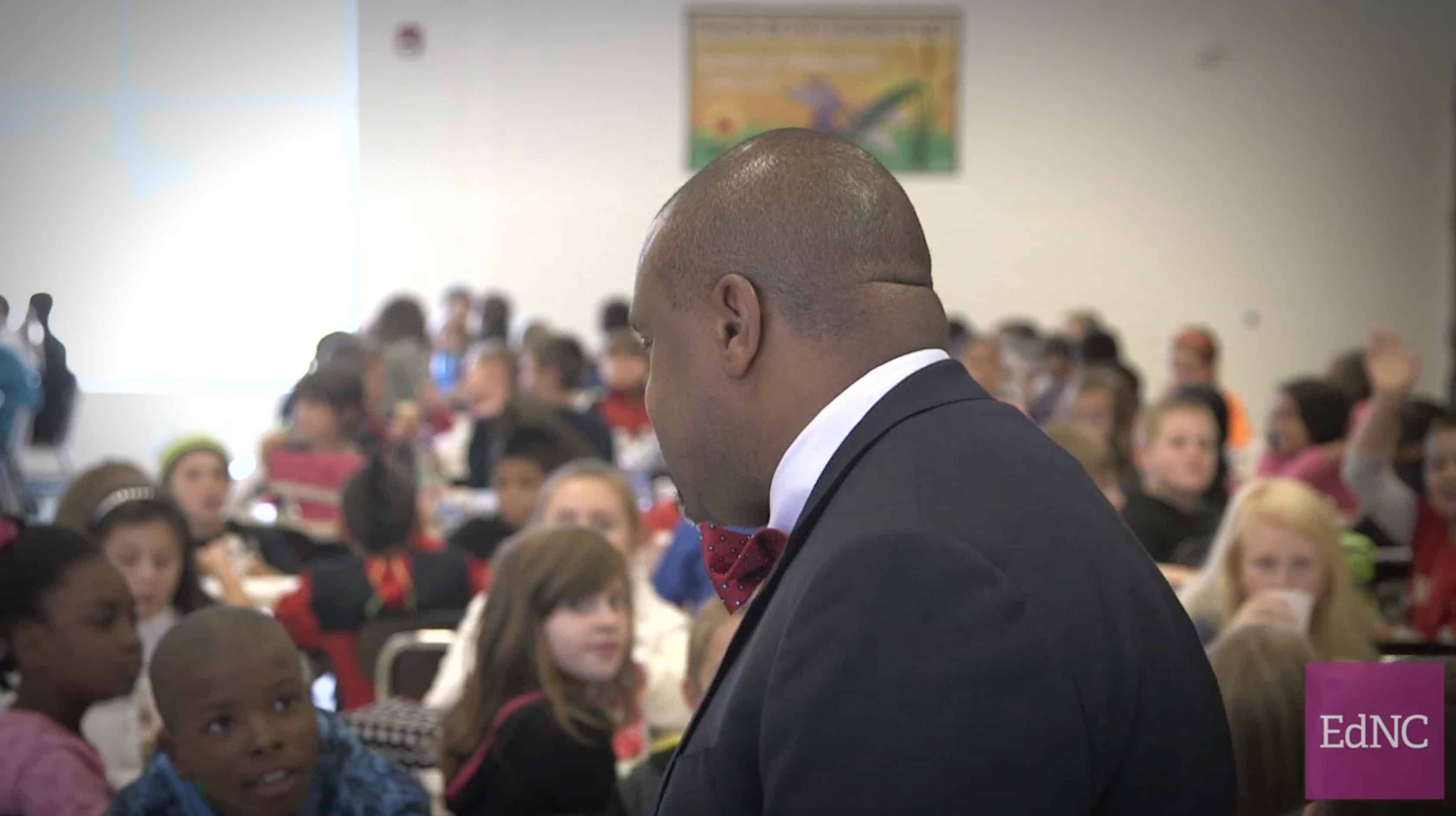When Katie McMillan became principal of Centennial Campus Magnet Middle School in Raleigh in 2014, she didn’t realize she was locking herself into one pay level for half a decade. According to the principal salary schedule, it will be 2019 before she gets her next pay bump from the state, and she worries that long waits for raises could affect the quality of leadership in public schools.
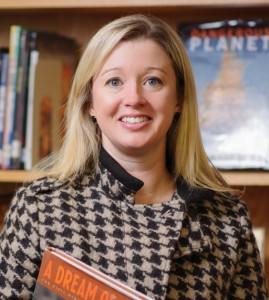
“I think that this is a highly complex job and if you don’t have good principals you’re not going to have a working environment for teachers,” she said.
This is just one issue facing principals in a time when education has become one of the hottest political topics in the state. Some principals and officials are also concerned about principal retention, and unintended consequences from last session’s teacher raise that could result in some teachers making more than their administrators.
According to the state salary schedules for 2014-15, McMillan, who has 15 years of combined experience as a teacher and principal, will have to wait until her 20th year for a raise.
That’s because for a principal who oversees between 44 and 54 teachers — the category McMillan falls under — the first level of pay is $4,918 a month or $59,016 a year. But that base level is given to all principals who fall within a range of experience from zero to 19 years. It’s not until the 20th year that the pay given by the state bumps up to $4,983 or $59,796 annually. That means McMillan has a long wait.
“I think that that is not the kind of schedule that is going to hold up over time,” said state Board of Education Chairman Bill Cobey. “That is based on number of years and that’s it, and that’s not the world we live in.”
And the problem isn’t restricted to principals at McMillan’s level. Those who oversee 11 to 21 teachers have to wait until their 16th year, and those who oversee 22 to 32 teachers will be stuck at the same pay level until their 18th year. The wait is the worst, however, for principals at the highest level — those who oversee 101 or more teachers. The first pay bump doesn’t come until the 24th year.
The problem has been exacerbated by pay freezes which began in 2009 in the wake of the economic recession and continued through 2013, with the exception of a one-time salary increase of 1.2 percent in 2012.
“With the salary freezes, the groupings have gotten larger,” said Andrew Cox, section chief of school reporting at the state Department of Public Instruction.
That’s in a state whose average yearly salary ($67,850) for administrators — including assistant principals, principals and other positions with similar job duties, but excluding superintendents — is second to last in the nation, beating only West Virginia.
To avoid increasing the salaries of principals in the first range of pay, the range was increased by one year for each year of the pay freeze by the General Assembly, according to Cox. So, if the first range was 0-22 years for principals with the most responsibility one year, then the next year it became 0-23 years during the pay freeze. That’s in a state whose average yearly salary ($67,850) for administrators — including assistant principals, principals and other positions with similar job duties, but excluding superintendents — is second to last in the nation, beating only West Virginia, according to data compiled from the U.S. Bureau of Labor Statistics.
Cox points out, however, that the General Assembly tends to give across-the-board increases regularly. In fact, looking back to the 1993-94 school year, no more than three years have passed in a row without a pay increase, but these are mostly cost-of-living increases rather than raises, Cox said. The longest period of stagnation was during the recent salary freeze.
Fortunately, the pay freeze thawed during the last General Assembly session. In addition to the teacher raises, the budget allowed principals to get a step increase. If that increase didn’t reach the next pay level, they received an $809 bonus, according to Lynda Fuller, information and communication specialist for the Department of Public Instruction. That may make the wait for a raise more bearable for McMillan, who should have received the bonus.
Rep. Chuck McGrady, a Republican who served in the 2013-14 General Assembly as co-chair of the appropriations subcommittee on education, said last session’s teacher raise was just a first step in improving education in the state.
“I would like to go back and look at principal salary schedules as it relates to teacher salary schedules and just what it takes to get the first pay bump,” he said.
While last session’s Republican-led General Assembly was in charge of public school pay, the current issue isn’t the fault of any one group of legislators. Cox has worked with DPI for eight years and says the principal salary schedule has been structured basically the same in that time. That means it’s persisted through at least the reins of two Democratic and one Republican governor, as well as multiple General Assembly sessions of varying member makeup.
Cox said it will take the General Assembly to find a fix for principal raise issues.
“We can’t change the law, so they are the ones that would have to take any action if they choose to,” Cox said.
Schedules Out of Sync
Issues stemming from the principal salary schedules extend beyond raise issues. When the General Assembly voted last session to increase teacher pay, it changed the teacher salary schedule in such a way that it fell out of step with the principal salary schedule.
That means that now, in some cases, teachers can make more money than principals, even if they both have the same levels of experience.
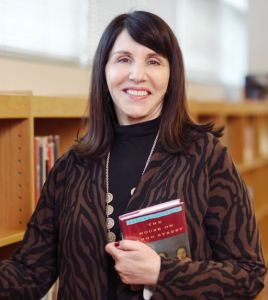
This is a huge problem, according to Shirley Prince, executive director of North Carolina Principals and Assistant Principals Association. She has written a position paper, arguing for reform of the schedules.
“The most recently enacted teacher salary schedule was an attempt to create a more competitive teacher compensation system,” the paper states. “However, an analysis of the new state salary schedules, shows that there now exists little to no financial incentive for a teacher to choose school leadership as a career path.”
Looking at the two salary schedules side by side, the issue becomes apparent. For example, a teacher with a master’s degree and 11 years of experience would get $4,400 each month from the state whereas a principal with the same years of experience who oversees up to 10 teachers would make $4,323. That principal would get an additional $126 per month for an earned advanced degree and $253 for a doctorate, giving him or her a slight salary advantage over the teacher. But if that same teacher had National Board Certification, he or she would get a salary boost to $4,880 a month. The schedule is full of such disparities. Prince’s argument is that there is no financial value for teachers to take jobs as principals if the pay is little more or less.

Jack Davern has experienced this problem first-hand. He is a principal at Elon Elementary School in the Alamance-Burlington School System. He’s been a principal now for seven years, but his transition was a rocky one financially.
“I have a masters and I’m nationally board certified as a teacher,” he said. “And when I went into administration, I actually made less.”
To address this issue, Prince has been talking with Governor Pat McCrory’s education advisor, Eric Guckian, who says lawmakers need to look at this situation in the upcoming session.
“We need education to be a destination and not a layover,” he said. “I think we certainly need to think about what we do next with rewarding principals.”
Guckian said he doesn’t think the issue is calamitous for schools, however.
“The soundbite of the sky is falling because some teachers are making more money than principals, that’s the part that I don’t necessarily buy into,” he said.
The issue is blurred further by the fact that most school districts have local supplemental funds they can use for educators. The state salary schedule is a base pay upon which schools often add these supplements to salaries for teachers, principals and other workers. A few school systems — Dare, Macon, Madison and Warren — offered no principal supplement for the 2013-14 school year, but most did, and the average ran anywhere from $100 in Mitchell County Schools to $28,022 for Charlotte-Mecklenburg schools, according to the Department of Public Instruction’s statistical profile.
In some school districts, principals are actually able to negotiate for more if the district has the funds.
With supplemental salary, the usual practice is for the school system to give a principal the state’s portion of the salary, plus a standard supplement. For instance, in Orange County, in addition to the salary given by the state, the county gives locally funded supplements of $12,000 for elementary school principals, $17,000 for middle school principals, and $23,000 for high school principals. But in some school districts, principals are actually able to negotiate for more if the district has the funds.
Alexander County negotiates a supplement for its only high school principal, according to Associate Superintendent Jeffrey Peal. And Charlie Glazener, executive director for community relations and communications for Asheville City Schools, said negotiations sometimes happens there.
“I would say we have some flexibility to try and be competitive but that is certainly the exception and not the rule,” he said in an email.
An EducationNC survey of state principals found that about 8.2 percent of the 219 principals who responded said they have negotiated their salaries at some point.
The respondents named some of the places where they say negotiations have happened, including districts such as Charlotte-Mecklenburg, Wake, Randolph, and Jackson counties, among others.
James Davis, an Associate Professor of Education at High Point University who spent nearly a decade working as a principal in North Carolina schools said, in at least one case, he was able to negotiate for salary.
“I really think it totally depends upon the county,” he said. “And I think it totally depends upon the school.”
McGrady said the salary schedule imbalance between principals and teachers was something he heard about last session, but only after the teacher salary increase had already passed. He says it’s something he wants to look at in the current session.
The Loss of Good Principals
All of these salary issues could have a negative impact on the desire of principals to stay in their chosen profession or teachers thinking of going into administration. Certainly that is a concern of Prince, and one shared by current principals like Davern.
“I don’t think the general public really understands the pressures,” Davern said. “And I think a pay scale should reward those who are out there and making sure that the buildings are safe.”
Matthew Ellinwood, a policy analyst for the Education & Law Project at the North Carolina Justice Center, said that keeping principals is important because they’re integral to the well-being of a school.
“The only way schools have been able to turn around is to have not only good teachers but good leaders as well,” he said.
Prince agrees that good principals are essential.
“You won’t ever find a really good school without a really good principal,” she said.
Davis said issues involving pay may factor into some principals’ decision to leave the job, but there are other factors as well.
“Other people leave the principalship because quite honestly I think the workload, if you do it effectively, is so overwhelming and time consuming,” he said.
The data do not include those principals who have moved between schools in the same district. And different turnover rates can be calculated depending on how officials parse the results.
The preliminary turnover rate for principals in North Carolina was 9.19 percent for the 2013-14 school year, according to the State Department of Public Instruction. Those are the most recent numbers available from the state, but that rate only includes principals who no longer work in the district. The data do not include those principals who have moved between schools in the same district. And different turnover rates can be calculated depending on how officials parse the results.
For example, between August of 2013 and August 2014, Charlotte-Mecklenburg schools lost 21 principals. During the 2013-14 school year, 159 schools were operating in the district, according to Stacy Sneed, media relations specialist for the school system. If you use that number as a basis for calculation, the school district had a 13.2 percent turnover rate. By August 2014, the district had 164 schools. Using that number, the turnover rate calculates to 12.8 percent.
Amy Hawn Nelson, director of research for the UNC Charlotte Urban Institute, looked at the principal turnover rates for Charlotte-Mecklenburg schools and included principals who moved between schools in the district as well. Using data from a FOIA request to the school system which listed 160 schools (one additional school opened halfway through the year), she found a 31.8 percent rate for the 2013-14 school year. That’s measuring from August 2013 to August 2014. When she looked at July to July of that same period, she got a rate of 40.6 percent.
Sneed said that for the time period of August 2013 through August 2014, 23 principals transferred between schools in the district. If that number is added to the 21 who left the district, the turnover rate for the district becomes 27.7 percent if you are using 159 schools as the base, and 26.8 percent if you use 164 schools — both much closer to Hawn’s findings. Further information to clarify the discrepancy between Hawn’s numbers and the school districts’ could not be obtained.
Adding in principals who leave their school to go to another in the same district is important because becoming a successful leader takes time, Davis said.
“You look at some schools and there is a turnover rate every year or two or three,” he said. “You can’t get as good of a result as quickly.”
Rep. McGrady said turnover between schools isn’t that concerning to him. He said it makes sense that a principal would want to work his or her way up from an elementary to middle to high school in the same district, for instance.
“It’s not really turnover,” he said. “You’re just making a decision.”
But whether intra-district transfers are considered professional development or principals are pursuing them for an increase in pay, the result is a change in leadership of a school.
For a short version of this article, click here.
View press release on this article.
Editor’s Note: Shirley Prince is on the Board of Directors of EducationNC.
Recommended reading
